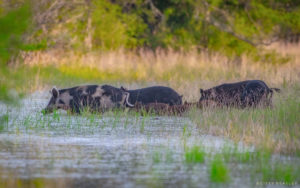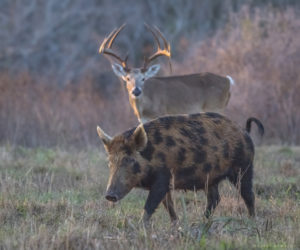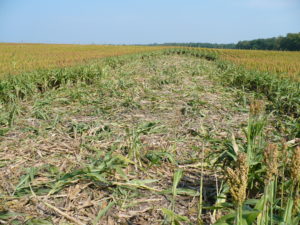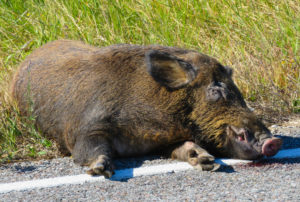Damage caused by feral hogs is not a new phenomenon, but it is becoming a more common experience for property owners across the state of Texas and throughout the ever-growing range of these invasive animals. Feral hogs are capable of occupying a variety of habitats, so their impacts are just as diverse as the ecosystems encompassed by their range.
Impacts to Natural resources

A group of feral hogs walk through a body of water in San Patricio County, TX. Photo Courtesy of Cissy Beasley.
A feral hog’s inability to thermoregulate means that they are often concentrated near a water source. This puts more sensitive habitats such as riparian corridors and wetlands at a greater risk of being damaged. Rooting and wallowing behaviors can damage and uproot aquatic vegetation, can contribute to increased erosion of banks, increased sedimentation of waterbodies, and increase turbidity or murkiness of water. Additionally, feral hogs in a riparian area can distribute fecal matter that introduces E.coli to the water system, they can alter the pH levels of the water, and can reduce dissolved oxygen levels. These effects combined can have serious impacts on the health of a watershed and on the organisms that rely on those habitats.
Additionally, feral hog foraging behaviors can also impact vegetation communities. A study of feral hogs in east Texas found that areas hogs were excluded from had a much higher proportion of native seedlings. These differences were attributed to high rates of mast (e.g. acorn) consumption by hogs, and the stress that frequent soil disturbance would have on seed germination and sapling trees. This study also found that areas with feral hog damage allowed for greater invasion of non-native plant species such as the Chinese tallow tree. These findings suggest that over time, feral hogs can contribute significant alterations of the ecosystems they inhabit.
Impacts to Wildlife

Feral hogs overlap with many native species including white-tailed deer. Photo courtesy of Cissy Beasley
Changes to important habitat can have direct impacts to native wildlife. Poor water quality in a riparian system can reduce abundances of freshwater muscles and aquatic insects. These changes can also negatively impact lager wildlife species who rely on those populations as a food source. Changes in vegetation communities can result in a lower production of acorns that native wildlife such as white-tailed deer, wild turkey, squirrel, and black bear rely on as a food source.
There are also more direct interactions between feral hogs and native species that are harmful. As opportunistic omnivores, the diet of feral hogs frequently leads to competition with native species. Aspects of their diet overlap with the diets of numerous native animals including white-tailed deer, wild turkey, black bears, waterfowl, and eagles to name a few. While the degree of overlap varies from one species to the next, the number of native wildlife species in direct competition with feral hogs helps convey the extent of their impact.
Not surprisingly, feral hogs can negatively impact native wildlife species through predation. As opportunistic omnivores, feral hogs can act as either predators or scavengers when the opportunity arises. While animal matter only makes up a portion of their overall diet, studies have identified remains from freshwater mussels, birds, armadillos, and toads in the stomachs of feral hogs. Additional studies have also documented depredation of white-tailed deer fawns, turkey nests, and quail nests when the opportunity is available.
Impacts to Agriculture
The impact that feral hogs have on agriculture is somewhat easier to financially quantify than some of the other impact categories, but estimates can still vary widely. A 2020 study analyzing damages to crops across 12 states known to have feral hog populations, estimated that feral hog damage resulted in $272 million in losses to crop production in a single year. A study from 2021 in Texas found that impacts to individual producers can costs upwards of two hundred thousand dollars annually when losses, management efforts, and lost opportunities are all taken into account.
The feral hogs foraging behavior can cause several direct impacts to crop production. Rooted areas can cause loss of harvestable crops, seeds and seedlings can be consumed during foraging, and irrigation systems can be damaged by rooting or wallowing. Indirectly, heavily rooted areas with rough terrain can slow down harvest equipment which requires more fuel and can cause additional wear and tear to equipment. There are also financial losses due to selecting a crop less likely to be damaged. Producers may elect to plant a less productive or less profitable crop in an area that has large quantities of hog damage, to avoid the potential damage associated with a more desirable crop such as corn.
There can also be impacts to livestock production efforts that overlap with the range of feral hogs. The rooting behavior of feral hogs can damage pastures and sometimes facilitate weed encroachment. The loss of grazing opportunity can directly contribute to production loses or repair costs. Additionally, feral hogs can cause conflicts for supplemental feeding efforts by consuming the feed intended for livestock. Feral hogs can also impact the health of livestock populations through the potential transmission of diseases. While the impact of hog borne diseases can be hard to quantify, the costs of additional vaccines is can add up quickly for producers. Finally, feral hogs can impact livestock populations through outright predation and have been documented predating young goats, sheep, and in some cases, young calves.
Impacts to Humans
Feral hogs can also have more human focused impacts in urban and sub-urban environments. In these settings, rooting and wallowing behaviors can cause costly damage to lawns and sport fields, as well as the irrigation systems that care for them. In neighborhoods, hogs have been known to specifically target gardens and flowerbeds and can damage outdoor furniture and fencing.
Feral hogs also present concerns to human health and safety. The E.coli introduced to natural waterways through feral hog fecal matter can also be introduced into artificial water system found in close proximity to humans. They can also carry a myriad of diseases that are transmissible to humans or pets. Feral hogs can cause property damage, human injury, and human fatalities through vehicle collisions. Feral hogs have a short frame, are typically dark in color, and have reduced eye shine which makes them especially susceptible to vehicle collisions. Although rare, human injury and death have also been documented from feral hog attacks. As both human and feral hog populations continue to expand, conflicts between the two groups will continue to increase.

